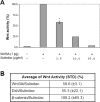Sulindac inhibits canonical Wnt signaling by blocking the PDZ domain of the protein Dishevelled
- PMID: 19637179
- PMCID: PMC2978498
- DOI: 10.1002/anie.200902981
Sulindac inhibits canonical Wnt signaling by blocking the PDZ domain of the protein Dishevelled
Figures




References
-
- Thun MJ, Henley SJ, Patrono C. J. Natl. Cancer Inst. 2002;94(4):252. - PubMed
- Brown JR, DuBois RN. J Clin. Oncol. 2005;23:2840. - PubMed
- Webster WS, Leibovich BC. Expert Rev. Anticancer Ther. 2005;5:957. - PubMed
- Lim JT, Joe AK, Suzui M, Shimizu M, Masuda M, Weinstein IB. Clin. Cancer Res. 2006;12:3478. - PubMed
-
- Ulrich CM, Bigler J, Potter JD. Nat. Rev. Cancer. 2006;6:130. and references therein. - PubMed
-
- Boon EM, Keller JJ, Wormhoudt TA, Giardiello FM, Offerhaus GJ, van der Neut R, Pals ST. Br. J. Cancer. 2004;90:224. - PMC - PubMed
- Gardner SH, Hawcroft G, Hull MA. Br. J. Cancer. 2004;91:153. - PMC - PubMed
- Barker N, Clevers H. Nat..Rev. Drug Discov. 2006;5:997. and references therein. - PubMed
- Sauter A, Matharu R, Braun T, Schultz J, Sadick H, Hormann K, Naim R. Arch. Med. Res. 2007;38:367. - PubMed
- Han A, Song Z, Tong C, Hu D, Bi X, Augenlicht LH, Yang W. Eur. J. Pharmacol. 2008;583:26. - PMC - PubMed
- Piazza GA, Alberts DS, Hixson LJ, Paranka NS, Li H, Finn T, Bogert C, Guillen JM, Brendel K, Gross PH, Sperl G, Ritchie J, Burt RW, Ellsworth L, Ahnen DJ, Pamukcu R. Cancer Res. 1997;57:2909. - PubMed
-
- Moon RT, Kohn AD, De Ferrari GV, Kaykas A. Nat. Rev. Genet. 2004;5:691. and references therein. - PubMed
- Logan CY, Nusse R. Annu. Rev. Cell Dev. Biol. 2004;20:781. - PubMed
- Klaus A, Birchmeier W. Nat. Rev. Cancer. 2008;8:387. - PubMed
- Wallingford JB, Habas R. Development. 2005;132:4421. and references therein. - PubMed
- Pan W, Choi SC, Wang H, Qin Y, Volpicelli-Daley L, Swan L, Lucast L, Khoo C, Zhang X, Li L, Abrams CS, Sokol SY, Wu D. Science. 2008;321:1350. - PMC - PubMed
Publication types
MeSH terms
Substances
Grants and funding
LinkOut - more resources
Full Text Sources
Other Literature Sources
Molecular Biology Databases

